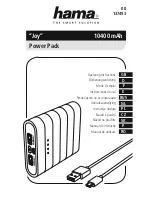
Correct way to hold
the demolition hammer
5
ENGLISH
Safety warnings for the use
of Demolition Hammers
• The tool is designed to work with bits
or accessories with 1 1/8" HEX shanks. Choose the
appropriate one for the material to be worked on, this
reduces the risk of serious injury and speeds up the work.
• Do not attempt to use bits that exceed the capacity of the
drill.
• Use well-sharpened and well-conditioned drill
bits/accessories to optimize the work.
Choose the appropriate drill or attachment
• Take your time to evaluate the work to be done and
make sure you have followed all the necessary precautions
before starting to drill.
• Fit the accessory correctly to the
chuck, otherwise it can be thrown out at high speed and
cause serious injury.
• Before hitting a wall, floor or ceiling,
make sure there are no embedded objects, such as wires
or electrical conduits or pipes.
• Make sure the switch is off (page 8
Start-up) before connecting the tool, otherwise it will start
working unexpectedly, which can cause serious injury.
• Turn off and disconnect the tool before
installing or replacing an accessory.
• This electric tool produces an
electromagnetic field during its operation that could
interfere with medical implants. To reduce the risk of
serious or fatal injury, it is recommended that people with
medical implants consult their physician and the
manufacturer of the implant before operating the tool.
Before operating the demolition hammer
•
Hold the tool by its handle and by
the auxiliary handle.
Remember that loss of control can
cause personal injury.
•
Hold the tool by its insulating surfaces, especially
when performing work where the cutting portion of
the drill may contact hidden wiring or the tool's own
power cord.
Contact with a live wire also makes the
metal parts of the tool live and can cause an electric
shock to the operator.
• Do not subject the tool to excessive stress.
• If the drill bit gets stuck in the
workpiece, turn off the demolition hammer immediately.
Then remove the drill bit from the workpiece. Do not
attempt to remove jammed bits by turning the tool on
and off.
• Do not put too much pressure on the tool to speed up
the drilling. Otherwise, the drill bit will be damaged and
the efficiency of the tool will decrease as well as its life
span.
• The larger the chisel area, the greater
the reactive force, which can lead to a loss of control of
the tool. To avoid this possibility, hold the tool firmly with
both hands and maintain a balanced position on both feet
while drilling at 90°.
• Be careful and ready to relax the force as soon as the
drill bit penetrates the material. Sudden movements can
cause accidents.
• Do not touch the chisel or drill holes
immediately after drilling. Wait for them to cool down
before handling them. Do not try to cool them with water
or oil.
• Avoid placing the tool in a place with particles and/or
dust immediately after use, these can be absorbed into
the tool mechanism and thus damage it.
• Use headset protectors, when running services that
make noise above 85 dB. Exposure to noise can cause
hearing loss.
• Use a dust mask and dust extraction equipment if
necessary. Remember that working with materials such as
asbestos, lead paint, additives, some types of wood,
metals, or minerals is highly toxic.
• Wear safety goggles.
While operating the demolition hammer
CAUTION
CAUTION
CAUTION
CAUTION
CAUTION
WARNING
WARNING
WARNING
DANGER
DANGER






































